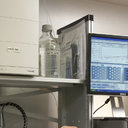Arbuscular Mycorrhizal Fungus Species Dependency Governs Better Plant Physiological Characteristics and Leaf Quality of Mulberry (Morus alba L.) Seedlings.
Kľúčové slová
Abstrakt
Understanding the synergic interactions between arbuscular mycorrhizal fungi (AMF) and its host mulberry (Morus alba L.), an important perennial multipurpose plant, has theoretical and practical significance in mulberry plantation, silkworm cultivation, and relevant textile industry. In a greenhouse study, we compared functional distinctions of three genetically different AMF species (Acaulospora scrobiculata, Funneliformis mosseae, and Rhizophagus intraradices) on physiological and growth characteristics as well as leaf quality of 6-month-old mulberry seedlings. Results showed that mulberry was AMF-species dependent, and AMF colonization significantly increased shoot height and taproot length, stem base and taproot diameter, leaf and fibrous root numbers, and shoot and root biomass production. Meanwhile, leaf chlorophyll a or b and carotenoid concentrations, net photosynthetic rate, transpiration rate and stomatal conductance were generally significantly greater, while intercellular CO2 concentration was significantly lower in AMF-inoculated seedlings than in non-AMF-inoculated counterparts. These trends were also generally true for leaf moisture, total nitrogen, all essential amino acids, histidine, proline, soluble protein, sugar, and fatty acid as they were significantly increased under mycorrhization. Among these three tested AMFs, significantly greater effects of AMF on above-mentioned mulberry physiological and growth characteristics ranked as F. mosseae > A. scrobiculata > R. intraradices, whilst on mulberry leaf quality (e.g., nutraceutical values) for better silkworm growth as F. mosseae ≈A. scrobiculata > R. intraradices. In conclusion, our results showed that greater mulberry biomass production, and nutritional quality varied with AMF species or was AMF-species dependent. Such improvements were mainly attributed to AMF-induced positive alterations of mulberry leaf photosynthetic pigments, net photosynthetic rate, transpiration rate, and N-containing compounds (methionine, threonine, histidine, and proline). As a result, application of Funneliformis mosseae or A. scrobiculata in mulberry plantation could be a promising management strategy to promote silkworm cultivation and relevant textile industry.



